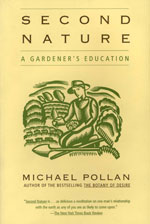
David Douglas was a Scottish botanist, best known as the namesake of the Douglas fir. He worked as a gardener, and explored the Scottish Highlands, North America and Hawaii, where he died. The standard author abbreviation Douglas is used to indicate this person as the author when citing a botanical name.

Liberty Hyde Bailey was an American horticulturist and reformer of rural life. He was cofounder of the American Society for Horticultural Science. As an energetic reformer during the Progressive Era, he was instrumental in starting agricultural extension services, the 4-H movement, the nature study movement, parcel post and rural electrification. He was considered the father of rural sociology and rural journalism.
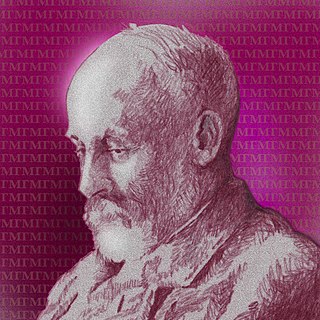
William Robinson: was an Irish practical gardener and journalist whose ideas about wild gardening spurred the movement that led to the popularising of the English cottage garden, a parallel to the search for honest simplicity and vernacular style of the British Arts and Crafts movement, and were important in promoting the woodland garden. Robinson is credited as an early practitioner of the mixed herbaceous border of hardy perennial plants, a champion too of the "wild garden", who vanquished the high Victorian pattern garden of planted-out bedding schemes. Robinson's new approach to gardening gained popularity through his magazines and several books—particularly The Wild Garden, illustrated by Alfred Parsons, and The English Flower Garden.

Michael Kevin Pollan is an American journalist who is a professor and the first Lewis K. Chan Arts Lecturer at Harvard University. Concurrently, he is the Knight Professor of Science and Environmental Journalism and the director of the Knight Program in Science and Environmental Journalism at the UC Berkeley Graduate School of Journalism where in 2020 he cofounded the UC Berkeley Center for the Science of Psychedelics, in which he leads the public-education program. Pollan is best known for his books that explore the socio-cultural impacts of food, such as The Botany of Desire and The Omnivore's Dilemma.

The Royal William rose, registered under the cultivar name "KORzaun", is a red hybrid tea rose. It was developed by Reimer Kordes from the cultivar 'Feuerzauber' and is available under several other marketing names, such as Fragrant Charm, Duftzauber, La Magie du Parfum and Leonora Christine.
The American Horticultural Society (AHS) is a nonprofit, membership-based organization that promotes American horticulture. It is headquartered at River Farm in Alexandria, Virginia.
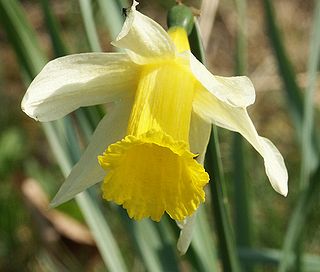
Narcissus pseudonarcissus, commonly named the wild daffodil or Lent lily, is a perennial flowering plant.
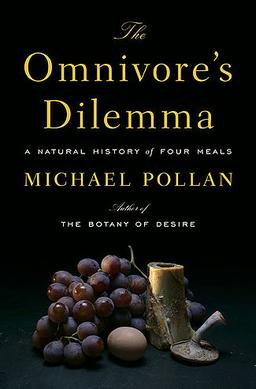
The Omnivore's Dilemma: A Natural History of Four Meals is a nonfiction book written by American author Michael Pollan published in 2006. As omnivores, humans have a variety of food choices. In the book, Pollan investigates the environmental and animal welfare effects of various food choices. He suggests that, prior to modern food preservation and transportation technologies, the dilemmas caused by these options were resolved primarily by cultural influences.
David Streatfield is a widely recognized historian of landscape architecture and long-time professor in the Department of Landscape Architecture at the University of Washington.

Tulips are spring-blooming perennial herbaceous bulbiferous geophytes in the Tulipa genus. Their flowers are usually large, showy, and brightly coloured, generally red, orange, pink, yellow, or white. They often have a different coloured blotch at the base of the tepals, internally. Because of a degree of variability within the populations and a long history of cultivation, classification has been complex and controversial. The tulip is a member of the lily family, Liliaceae, along with 14 other genera, where it is most closely related to Amana, Erythronium, and Gagea in the tribe Lilieae.
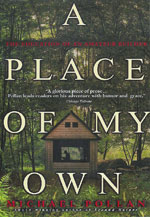
A Place of My Own: The Education of an Amateur Builder was Michael Pollan's second book, after Second Nature: A Gardener's Education (1991). In 2008 it was re-released and re-titled as A Place of My Own: The Architecture of Daydreams.

Alys Fowler is a British horticulturist and journalist. She was a presenter on the long-running BBC television programme Gardeners' World.

Janet Meakin Poor was a landscape design specialist based out of Winnetka, Illinois. She was the great great niece of American impressionist painter Lewis Henry Meakin.
Donald Wyman was an American horticulturist, the head of horticulture at Harvard University's Arnold Arboretum from 1935 to 1970.
Margery Fish was an English gardener and gardening writer, who exercised a strong influence on the informal English cottage garden style of her period. The garden she created, at East Lambrook Manor in Somerset, has Grade I listed status and remains open to the public.
Patrick Millington Synge (1910-1982) was a British botanist, writer and plant hunter.
Louise Beebe Wilder was an American gardening writer and designer whose books are now considered classics of their era.
Wendy Felicité Walsh was an artist born in Cumbria who lived and worked in Ireland and was a prolific botanical illustrator.
Robert Stell Lemmon, often Robert S. Lemmon in publications, was an American writer and naturalist. He wrote and lectured on domestic dogs, gardening, wildlife, wild flowers and trees. Most of his writing was non-fiction, but in 1923 he also wrote an adventure short-story called The Bamboo Trap, about an American entomologist caught in a cave in the Ecuadorian jungle.
